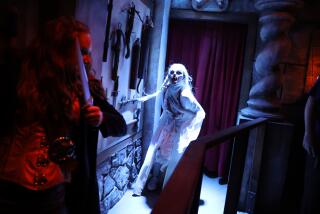The Frankensteins Are Within Us
As many children and more than a few adults don Frankenstein masks and assume other monstrous identities in Halloween celebration, they are mainly inspired by movies, cartoons, comic books--the fake-ghoulish entertainment media. Nearly lost in the shuffle is Mary Wollstonecraft Shelleyâs visionary novel, âFrankenstein, or the Modern Prometheus,â published in 1818, whose once-fantastic proposition of replicating human life is now within the realm of possibility.
The novel was written on a dare during a rainy summer on Lake Geneva, when Mary and Percy Bysshe Shelley and their neighbor Lord Byron tried to outdo each other in imitating the German ghost stories they were reading.
Yet the scientist Victor Frankenstein (a ânatural philosopherâ in the parlance of that time) and the monster he created to become his own torment and doom were more than characters in a conventional Gothic romance. For Mary Shelley, their story was a cautionary tale about the potential destructive powers of science indiscriminately unleashed. She wrote:
âThe ancient teachers ... promised impossibilities and performed nothing. The modern masters promise very little; they know that metals cannot be transmuted and that the elixir of life is a chimera. But these philosophers, whose hands seem only made to dabble in dirt, and their eyes to pore over the microscope or crucible, have indeed performed miracles. ... They have acquired new and almost unlimited powers; they can command the thunders of heaven, mimic the earthquake and even mock the invisible world with its own shadows.â
More than a century and a half later, Shelley has proved prescient. We have indeed harnessed science to produce miracles, but we also have misused science to annihilate millions in wars, to pollute our environment and to mass-produce junk with a nearly religious zeal. On this holiday, when we play at scaring each other with masks and moans, we also harbor genuine fears of tomorrow in a tension-ridden world where psychological disorder is epidemic and our hatred for each other, due to our differences, ever present.
At the same time, as scientists chart the brain and fill in our genetic blueprint, possibilities emerge for creating ideal human beings who would neither hate nor attract hatred, have truly immune systems to defy death and possess agile minds to function in parallel universes and unlock the last mysteries of matter.
Perhaps it is time to agree with existentialist philosophers who for the better part of this century have contended that human beings are not wholly natural, that we are programmed to alter nature, to bend and break its rules and transform it according to our own impulses. In our still-crude stages of development, we have dammed rivers, dynamited mountains, made deserts bloom and laid rain forests to waste. In a fast-approaching future, as atoms and molecules become our playthings, we are destined to sever our last ties with nature and exercise further our ânew and almost unlimited powers.â We may even be able to become monsters for a night on Halloween instead of pretending behind malodorous rubber masks.
Our lives are to become even weirder, limned in ceaselessly shifting twilights of fantasy and fact, being and death, childâs play and catastrophe, fears and superstitions as antediluvian as cave art, and hopes as brave as immortality. The ancient Celts, who observed the autumnal rites of Samheen to honor the return of the dead, knew what modern religions confirm: The human soul is undying; we are, during our days on this Earth, accompanied by living spirits of those who came before us.
As technology further evolves to surpass biology, a day may come when our progeny can actually commune with our electronically preserved âliving spirits.â With such a world awaiting, it behooves us to get into the spirit of Halloween to honor the memories of the Celts and of Mary Shelley, to take stock of our own capacities for illimitable kindness and cruelty, to recognize in ourselves anenormous immaturity that impels us to abuse science in the most mercenary and murderous ways.
In short, this is a good time to contemplate a moral vision commensurate with our scientific advances. To enhance the clarity of this cognition, go easy on the candy.
More to Read
The biggest entertainment stories
Get our big stories about Hollywood, film, television, music, arts, culture and more right in your inbox as soon as they publish.
You may occasionally receive promotional content from the Los Angeles Times.










